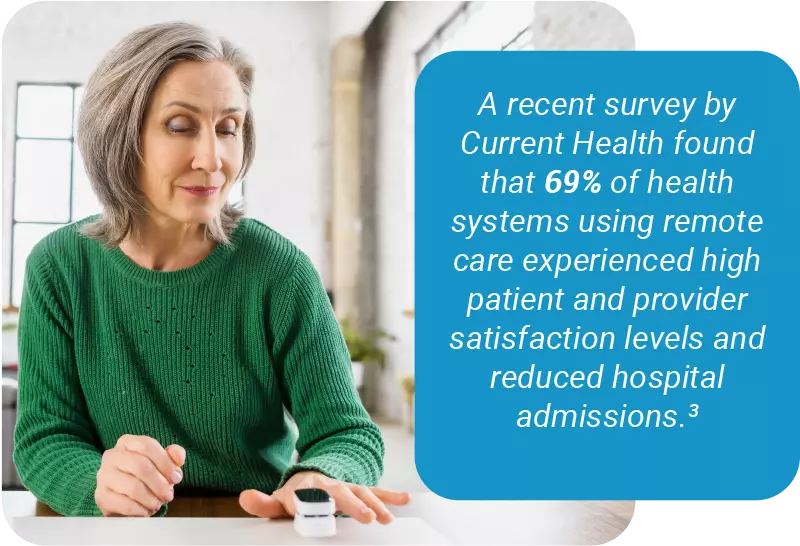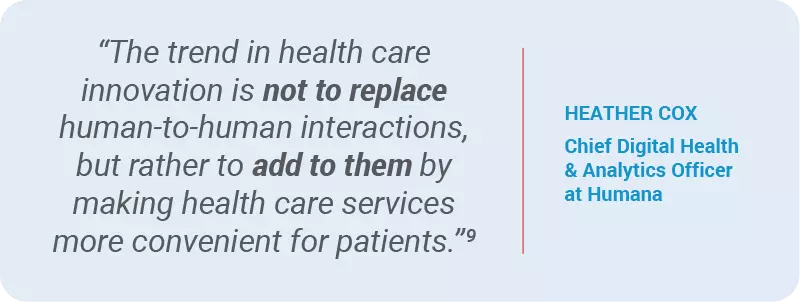Next Generation Care Delivery in the Home
By Spiras Health | May 20, 2022

A longitudinal approach to specialized care in the home helps patients with complex chronic conditions avoid the hospital.
Ask your parent or grandparent how they wish to age, and almost without exception, they want to be cared for in their home – nearly 90% according to a recent study.1
The problem is that approximately 85 percent of seniors are managing at least one chronic health condition, and 60 percent have at least two.2
A few years ago, aging at home with a complex chronic condition presented a host of challenges. Today, a longitudinal approach to care reduces avoidable hospitalizations, manages symptoms, and improves quality of life.
Episodic Versus Longitudinal Care
Episodic care treats a particular “episode” of care that has a foreseeable endpoint – a wound or an acute illness. Other examples of episodic care include cases treated in the ER, urgent care, and doctor’s office.
Complex, chronic conditions demand longitudinal care to manage symptoms, improve quality of life and reduce the need for ER visits and hospitalizations. They also require a high-touch model with a multi-modal approach in order to improve the opportunity to educate, identify triggers, and intervene on symptom exacerbations. Most patients can only see their physician in their offices 2-3 times a year. This infrequent connection to care team hinders patient’s ability to self-manage.
Next Generation Care Delivery at Home
Next Generation Care Delivery at Home offers a hybrid approach by combining nurse practitioners with field clinicians and smart technology to support longitudinal care in the home. Spiras Health has developed this multi-modal hands-on approach to leverage condition-specific knowledge, increase patient touchpoints, improve self-care, and enhance the patient/provider relationship.
Reducing Admissions
The goal of this new “care at home” model is to keep a patient as stable as possible in their disease progression and to intervene quickly in the event symptoms occur. Giving members 24/7 access to care and specially trained clinicians and supporting a member with frequent touchpoints in the home, helps to avoid unnecessary hospitalizations and ER visits. Complex conditions might include COPD or CHF combined with comorbidities like a GI disorder or complications from mental health, hypertension, or high cholesterol.

Condition-specific specialty care reduces avoidable risk by confirming diagnosis and level of progression, increasing plan compliance, medication adherence, symptom management, and ER diversion. Health plans enjoy a positive ROI, guaranteed savings, and increased member and provider satisfaction.
The home-based model uses digital communication, telehealth, and biometrics as needed to reinforce the in-person visits. A recent survey by Current Health found that 69% of health systems using remote care experienced high patient and provider satisfaction levels and reduced hospital admissions.3
The Pandemic Kickstarted Telehealth
Before the COVID-19, telehealth was approved mainly for rural patients.4 Overnight, the pandemic pushed CMS to make telehealth services available nationwide for a broad range of services. Telehealth usage jumped up to a 32% utilization rate from less than 1% before the pandemic.5
“What COVID may have done is accelerate everyone’s thinking about: how do you provide that optimal set of services in the home?” Joe Agostini, MD, Chief Medical Officer at UnitedHealthcare Retiree Solutions, explained to HealthPayerIntelligence.6
As a result, health plans are moving more aggressively to support older adults with complex needs in their homes.
“Home health” has always been around – typically for wound care, injections, managing an acute episode or providing assistance with medical equipment. What’s new is the ability to keep patients with complex needs out of the hospital by closely managing their care longitudinally while they stay at home.
Healthcare leaders surveyed by Current Health reported a growing desire to care for more higher-acuity patients in their own homes (69%). They also reported improved patient and provider satisfaction (63% and 62%). Additionally, they found that they could address long-term scaling challenges, including caring for more patients with limited clinical staff.7
Increased Investment in Care at Home
Research also found that 81% of health systems plan to increase investment in care at home – partly the result of a changing regulatory landscape incentivizing home-based care.8 CMS’s Acute Hospital Care at Home program is expected to become permanent in some form. The bipartisan Choose Home Care Act would also encourage care at home for higher acuity Medicare patients following hospitalization. To participate in these programs, healthcare leaders must incorporate digital technologies that can scale and deliver care efficiently.

The Care at Home Delivery Model
Spiras Health has developed a home-based delivery model for specialty care that quickly scales to meet changing medical needs. The patient-centered approach delivers a protocol consisting of:
- Home visits, telehealth visits, and 2-way digital communications
- If the condition warrants, remote patient monitoring
- Service frequency is based on the member’s risk, need, and and personal preference
The Spiras Health model is unique in its use of specialty-trained nurse practitioners to manage care for each patient. Field-based clinicians visit the member’s home to provide treatment, assessments, and exams. Each nurse practitioner oversees the field-based clinicians who manage a small panel of patients. The teams are overseen by a chief medical officer (pulmonologist) and two medical directors (cardiology and palliative care).
Improved Self-Care
One of the key benefits of the home delivery model is improved self-care. “Traditionally, a patient might visit their practitioner a few times per year,” said Sue Freeman, Vice President of Clinical Experience. “The home-based model provides several touchpoints per month at a minimum and creates a greater incentive for patients to adhere to their treatment plan and self-monitor for symptoms.”
“We have found that we are able to reduce hospitalizations and ER visits through more attentive self-care,” said Freeman. “The home model also optimizes quality metrics, reduces the administrative burden, and delivers positive ROIs.”
Technology Enhances the Patient Experience
Technology that supports care at home also offers a more personalized experience. Thanks to targeted risk assessments and detailed electronic health records, home-based providers can offer personalized care strategies for each patient. Telehealth, remote monitoring, digital communication, and in-home care make the experience vastly more convenient for the patient. Increasing touchpoints also improves outcomes by enhancing the frequency and depth of the patient’s contact with the health care system.
Operational Barriers
Despite the benefits of home-based specialty care, the Current Health survey found barriers to success, including patient and provider engagement, data and workflow integrations, and operational concerns. More than half of all survey respondents reported patient adoption and adherence as challenges they have faced with remote care solutions.
“Digital tools are not replacing doctors and traditional care options,” Heather Cox, chief digital health and analytics officer at Humana, wrote in a Boston Globe op-ed.9 “The trend in health care innovation is not to replace human-to-human interactions, but rather to add to them by making health care services more convenient for patients.”

With 42 percent of older Americans still lacking adequate broadband access at home, technology alone will not deliver next-generation care.10
“We discovered that remote technology solutions alone don’t work,” said Spiras Health’s Chief Medical Officer, David D. Hagaman, M.D. “A true provider relationship builds trust and accountability. Spiras Health has built a unique multi-modal approach to patient care centered around hands-on care. Telehealth and digital communication reinforce the in-person visit. We feel that this is the model for the future.”
To learn how to offer Spiras Health to your members with complex needs, contact us using the form below
- www.capitalcaring.org/nearly-90-of-americans-age-50-and-older-want-to-age-in-place/
- www.nia.nih.gov/health/supporting-older-patients-chronic-conditions
- www.businesswire.com/news/home/20210818005114/en/81-Of-Health-Systems-Plan-to-Increase-Investment-in-Care-at-Home-According-to-New-Current-Health-Research
- www.fiercehealthcare.com/payer/cms-has-finalized-permanent-telehealth-flexibilities-but-only-for-rural-areas-for-now
- homehealthcarenews.com/2021/09/humana-executive-data-analytics-key-to-a-home-focused-health-care-system/
- healthpayerintelligence.com/news/how-ma-plans-can-build-on-covid-19-home-healthcare-strategies
- www.businesswire.com/news/home/20210818005114/en/81-Of-Health-Systems-Plan-to-Increase-Investment-in-Care-at-Home-According-to-New-Current-Health-Research
- www.businesswire.com/news/home/20210818005114/en/81-Of-Health-Systems-Plan-to-Increase-Investment-in-Care-at-Home-According-to-New-Current-Health-Research
- www.bostonglobe.com/2021/09/06/opinion/future-home-health-care-is-now/[1] agingconnected.org/report/

 Prev
Prev